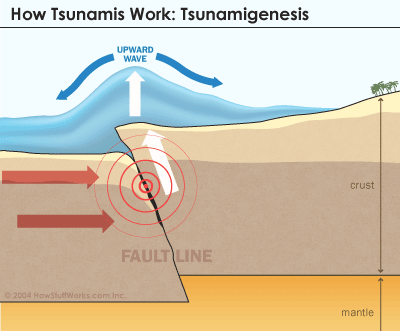https://trestlessurfcrowd.wordpress.com/2010/02/28/tsunami-physics-and-trestles/
Energy is gained by the transfer of earths crust from the earthquake or other natural disater that happens under the ocean to the water causing the wave height to grow. The velocity of the tsunami is generated by the sea floor deformation, which will aslo have an affect of the height of the wave. When the velocity of sea floor deforms it causes the main equilibruim position of the water to move, then causing displacement of the water mass resulting in gravity to move in an upward position, making the wave size increase as well.
A=Amplitude, w=period, and φ=phase constant
The maximum velocity can be defined as: v=sqrt(g*d)
g=gravitational constant=9.81m/s^2, d=depth

http://www.oceanminds.com/how-shallow-water-explain-tsunami/